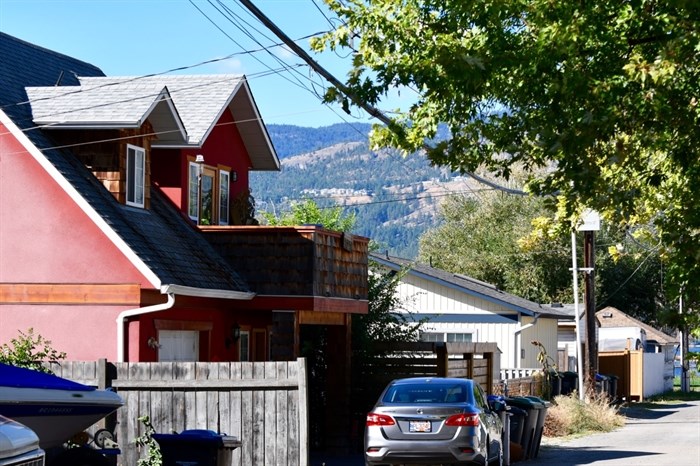
A carriage house in Kelowna's North End.
(JOHN MCDONALD / iNFOnews.ca)
September 14, 2017 - 9:00 PM
KELOWNA - Carriage houses, nanny suites, granny flats — whatever you want to to call them — are in Kelowna to stay.
Some 600 carriage houses — almost four per cent of the city’s rental housing stock — now dot the laneways and alleys around Kelowna’s downtown and nobody seems to think much about it.
But Kelowna was an early adopter and carriage houses were a local flashpoint in 2001 when city council first approved a staff plan for a new zoning category they said would help boost density and preserve the character of those neighbourhoods.
For the first three years, already doubtful neighbours made frequent and loud complaints when some monster carriage houses began popping up along Kelowna’s laneways and looming over people’s backyards.
By 2004, council of the day had squashed the maximum carriage house size down to 1.5 stories and made over the rules, requiring dormer-style windows for the second floor and reducing the maximum size to just under 1,000 square feet.
Since that rocky start, the carriage house program has seen stready growth with between 30 and 60 going up every year, while at the same time the rules governing their development have eased considerably.
“It’s a program I think this city should be proud of,” community planning manager Ryan Smith says. “They have managed to create substantial rental housing while largely keeping these neighbourhoods intact.”
Helping that along has been substantial changes and tweaks through the years to the development application and permitting process, cutting out some of the steps and making it much easier to get approval for homeowners willing to stay within established form and character guidelines.
So ubiquitous are carriage houses now in Kelowna’s back alleys, they are reaching a density where the city may have to look at improving the "lane-scapes", as Smith calls them, by adding features such as lighting and signage.
"It does add traffic to the laneways. As we continue to grow, we need to look ahead at what we can do to keep the livability standard high,” he says.
With the success of carriage houses comes imitation and the city introduced last year a new, denser zoning category for about 450 properties allowing three or even four suites to be constructed depending on the size of the lot.
Take-up has been slow, Smith admits, with just a dozen or so applications so far.
“Unfortunately, these properties tend to be expensive. These things take time for people to become aware of and to understand the rules”
Those rules will also be subject to constant review, Smith adds — they are taking some changes before council next week.
While the passing of time has helped make people more comfortable with carriage houses, Smith says concerns still persist and cannot be ignored.
“We still hear concerns about privacy and the neighbourhood associations often call to make sure something is being built correctly,” Smith says. “Fair enough, when it’s not done well, problems can arise.”
But the city is not about to abandon the program anytime soon, given the extremely tight rental housing market in the Central Okanagan.
“If everybody in the city put in a carriage house or a secondary suite, we wouldn’t have the rental housing problems we have,” Smith says.
To contact a reporter for this story, email John McDonald or call 250-808-0143 or email the editor. You can also submit photos, videos or news tips to the newsroom and be entered to win a monthly prize draw.
We welcome your comments and opinions on our stories but play nice. We won't censor or delete comments unless they contain off-topic statements or links, unnecessary vulgarity, false facts, spam or obviously fake profiles. If you have any concerns about what you see in comments, email the editor in the link above.
News from © iNFOnews, 2017